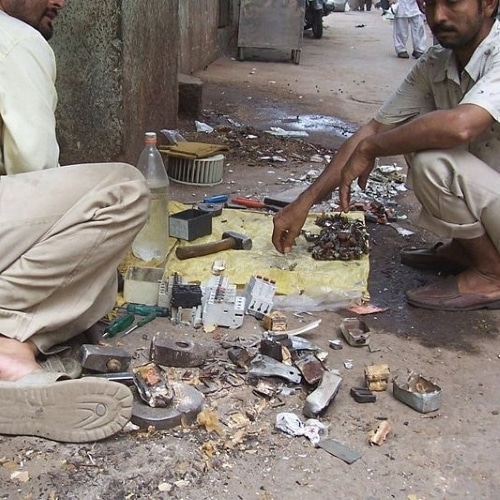There is a growing consensus that India is going through a waste crisis, and this awareness unfolds parallel to an increasing awareness of the beyond-human time it takes for plastics to disappear. It is striking that narratives of problems with waste, across different genres, often return to the same figures and figures of speech, the same heaps of numbers and piles of rubbish to give emphasis to the gravity of the affair. These elements reappear as ever more solidifying narratives, the repetitive patterns chalking out narratives of dysfunction that represent the waste crisis. Here I interrogate how such elements, figures of speech from earlier narratives of dysfunctional e-waste management, highlighting the threat of e-waste to the environment, are retooled into stories of success by private business. I do that through the story of a Producers’ Responsibility Organisation (PRO), a Delhi-based start-up I call Sahih Kaam (pseudonym to protect anonymity, meaning right or proper work in Hindi) that I worked closely with during fieldwork. I explore the powerful and influential tropes and imaginaries in action, put into practice by private companies in the pursuit of environmental and social change.
Narratives of problems with waste, across genres, often return to the same figures and figures of speech, the same heaps of numbers and piles of rubbish to give emphasis to the gravity of the affair.
The example of Sahih Kaam is revealing of a wider, but underexplored, trend of private sector solutions in a sphere where advocacy groups and their campaigns dominated until recently. The strength of the example lies in the extraordinary efforts by Sahih Kaam to groom action and processes to the high standards laid down by advocates of environmental justice, whereby we can begin to understand what it might mean to implement industrial processes in alignment with environmental criticism.
The narrative of dysfunction
Stories, along with myths and legends, have been important to anthropologists for long. Myths were what revealed the structure of a society for Levi-Strauss, but stories are also studied for the way in which they give a sense of agency to the storyteller over their fate (Jackson 2002). Unlike narratives of crisis (Seeger and Sellnow 2016), narratives of dysfunctional waste management are cultivated over a long period of time to highlight what may not be so readily apparent – the damage done by human intervention. Yet, they similarly open up a space of action (Roitman 2013) while determining the parameters and modes of that action. My aim here is to understand how stories of success about solving the issue of e-waste by private capital are told through the tropes and figures provided by earlier narratives of dysfunction told by environmental advocacy groups. More than that, I am interested in how these stories are told and retold from different subjective positions, and acquire slightly different meanings with every retelling (Maggio citing Boyd 2014).
The corpus of literature developed a vocabulary and imagery that included a visual language of women and children to emphasise the vulnerability of workers.
From the early 2000s, reports started appearing internationally of the toxic substances that would be released into air, water and soil when e-waste was not handled properly. The main concerns in these early reports was the lack of recycling in high consumption countries such as the US, with discards ending up in landfills or shipped to Asia, including India, to countries with lax or non-existent regulations and a large reserve of cheap labour with preponderance to inappropriate dismantling operations. In particular, incineration, open burning and other salvage techniques used in backyard operations were highlighted for their extremely high cost to the environment and the health of workers, often portrayed as victims. The corpus of literature, primarily available on the internet, developed a vocabulary and imagery that was then replicated over and over again in the following decades, including a visual language of women and children to emphasise the vulnerability of workers. The women in the images are usually depicted in the squalor that is now familiar from popular characterisations of urban mining.
The Delhi-based Toxics Link that helped e-waste become a global issue, as part of their campaign, had prepared, together with GIZ, the German development agency, a document detailing the requirements for a responsible e-waste recycling. The same document got accepted by government in a not significantly modified form. This is how the law enshrined Extended Producer’s Responsibility, or EPR, what a critical non-governmental group through research found to be an effective policy measure to manage e-waste. The first legislation was passed in 2011 and the second, the E-waste (Management) Rules of 2016, came into effect in 2017. EPR is most often talked about as a system in which producers are made to take responsibility for the entire lifecycle of the products that they make or sell. In the Indian context, this means that producers are bound by law to collect and responsibly dispose of a progressively increasing percentage of their items, calculated from previous years’ sales data to have become obsolete in a given year. Or, companies specialised in fulfilling EPR obligations, called Producers’ Responsibility Organisations, can step in to carry out collective responsibility. The number of PROs had proliferated in recent years, of which Sahih Kaam is one.
Commercial e-waste solutions and an economic rationality became privileged in a way that even surprised those who had brought it about.
While rooted in the critique of government and producers for reneging on their responsibility, the EPR framework gave legal parameters for the space of action opened up by the narratives of e-waste crisis, which incentivised private businesses. In this space, commercial e-waste solutions and an economic rationality became privileged in a way that even surprised those who had brought it about. When interviewing Mr Sinha, assistant director of Toxics Links, he responded emphatically when I asked him whether he had an idea about how the discussion shifted from an environmental concern to that of a business case. “This is something that I also don’t understand, this has become a business thing only. Now, I also find that many meetings that I go to, […] I don’t hear anything about the environment. Sometimes I get lost as to where am I sitting?!” Yet, in tacit acknowledgement of the shift in the narrative, he then slipped into detail about how to raise the money to dispose of e-waste properly the consumer had to pay. And if the consumer cannot be made to pay, the money would have to be raised in other ways, and that is why EPR became an important policy tool to the industry.
The Success Story as Business Case
Nothing demonstrates this better than the event organised to celebrate the cooperation between the PRO Sahih Kaam and its international investment organisation partner to showcase the viability of business in e-waste. When Sahih Kaam and its international partner, the investment arm of a major international development organisation, closed their year-long partnership, they threw an event. It was held on the top floor venue of a New Delhi downtown five-star hotel and the intention was to demonstrate the great investment potential in e-waste, and Sahih Kaam was the proof for this.
It was a carefully crafted event, where the dangers of e-waste to Earth and its population were demonstrated by a street play enacted by school children from Sahih Kaam’s school programme for awareness. The “civil society” opinion was represented by Mr Sinha, who chastised government inaction and failure to define the role of the informal sector waste dealers in the Rules. “The industry” was represented by Coca Cola, though “not from an e-waste but a plastics perspective,” and the industry duly took the opportunity to complain of the government’s blanket ban on plastics effectively making it impossible to sell their products. The man called the “father of EPR” was also present to explain why he chose the word responsibility when giving a name to the policy tool he invented. In addition, he also warned that the implementation of EPR required a smart and vigilant government. The government took the international investment organisation by its word and extolled the success of the private sector in solving the e-waste crisis. The founder of Sahih Kaam took to the podium to thank his staff for their incredible achievement within a very short period of time and highlighted that much that remains to be achieved, as much for his company as for “the industry” and the government.
Salvage economies are growing out of the possibilities provided by disaster capitalism – the waste crisis of yesterday is now a business opportunity.
As the international investment organisation’s turn came to demonstrate the success of the partnership, Vivek, the presenter pulled up a graph representing the growth and volumes of materials collected and disposed of in a responsible manner with certified registered recyclers. Against the solid magenta zigzag, the smiling face of a rural woman in black and white filled the background. The woman, Vivek said, is Suman Bai who made a shift from a solid waste worker to an e-waste collector. This, according to an online news article, brought her self-esteem and enough money to support her six children. The slide then showed the two things Sahih Kaam is most proud about: they had reached their yearly targets in collections, but they also did so by roping in informal sector workers and giving them a source of livelihood. They diverted a significant amount of toxic material from landfills and inappropriate processing, therefore protecting environment and human health.
The slide is also illustrative of how Sahih Kaam used the elements of the e-waste crisis discourse to build into their own self-presentation. The representation drew from the aesthetic language that developed as illustration to documents of advocacy and reportage, demonstrating the plight of e-waste workers through images of women and children working in less than sanitary conditions. However, instead of showing Suman Bai sitting in metallic squalor, on the slide of Sahih Kaam, she smiles a beatific smile at the growing amounts of e-waste collected and disposed of in the right way. She represents the human face of Sahih Kaam’s progress even if a significant amount of the company’s e-waste came from a small number of mid-level e-waste traders, called aggregators, who were almost all entirely male and not waste pickers themselves. Even if recruiting aggregators and establishing channels for e-waste recycling was no less of an accomplishment – no less a matter of pride and the subject of demonstrative metrics for the company – it was perhaps less picture-worthy in the context of the image narratives that now define the e-waste story.
The event was eventually a success, even if Piyush, one of Sahih Kaam’s staff commented, “they are talking like silent killers, nobody wants to take responsibility, it is an open cold war.” He was pointing out how despite appearing to be in total agreement, the different stakeholders at the event seemed to keep gently pushing responsibility around, which they, as employees of the a successful business, knew to make work extremely hard.
Conclusion
This post started with the question of the role of narratives of dysfunction in the fashioning of successful business cases. These stories are evocative of the way in which salvage economies are growing out of the possibilities provided by disaster capitalism – the waste crisis of yesterday is now a business opportunity. Thus, salvage economies are no longer in the domain of the informal, backyard operations, so derided in early environmental reports, they are also gaining ground among start-ups and companies founded and funded by India’s richest. The stories that they weave, using the elements environmental narratives fashioned by advocacy groups for protecting the environment, are instrumental in legitimising companies such as Sahih Kaam. As successful business cases are demonstrated, they shift the narrative focus from environmental protection to profit making. However, I wonder whether such stories also point to something more: even as they build on narratives of environmental crisis, they narrate a vision of utopia to contain the frictions – between prioritising livelihoods or human health and the environment – in the looming sustainability crisis.
References
Jackson, Michael. 2002. The Politics of Storytelling: Variations on a theme by Hannah Arendt. Copenhagen: Museum Tusculaneum Press.
Maggio, Rodolfo. 2014. “The anthropology of storytelling and the storytelling of anthropology.” Journal of Comparative Research in Anthropology and Sociology 5(2): 89–106.
Roitman, Janet L. 2013. Anti-Crisis. Durham: Duke University Press.
Seeger, Matthew W., and Timothy L. Sellnow. 2016. Narratives of Crisis: Telling Stories of Ruin and Renewal. Stanford: Stanford University Press.
Images:
Featured image by Matthias Feilhauer/Wikimedia Commons (unchanged; Creative Commons Attribution-Share Alike 2.0 Germany)









